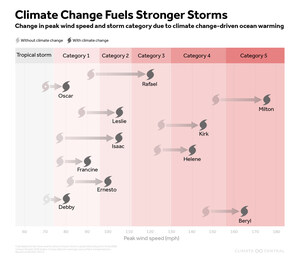Nationwide analysis, including census block group assessments of temperature amplification in 65 cities, identifies areas where residents face highest risks during extreme heat events
PRINCETON, N.J., July 10, 2024 /PRNewswire/ -- More than 5 million people in New York City, Chicago, and San Francisco live in environments capable of amplifying summer temperatures by at least 10 degrees Fahrenheit, according to a Climate Central analysis of 65 U.S. cities. Called urban heat islands, these areas will increasingly expose residents to higher heat-related health risks as climate change raises local temperatures.
For 145,000 living in the most extreme urban heat islands, the local built environment can push temperatures even higher, by 12 degrees Fahrenheit or more. Climate Central's analysis of census block groups – typically fractions of neighborhoods including a handful of city blocks – identified areas within 19 cities where factors such as building and paving materials, population density, and lack of greenspace can make temperatures far hotter than in neighboring communities.
Few city residents can avoid the influence of urban heat islands. Nearly 34 million – 68% of the population within the cities analyzed by Climate Central – live in environments capable of boosting temperatures by at least 8 degrees Fahrenheit. The analysis also quantifies and maps the impacts of urban heat islands beyond census-defined city limits, by census tracts, which typically include multiple block groups.
"Urban heat islands already expose residents to disproportionate heat risks and cooling costs, which will only climb as long as carbon pollution drives up global temperatures," Jennifer Brady, Climate Central's senior data analyst, said. "Until cities take action to cool these areas, people who live there will face the worst impacts of climate change."
The ten U.S. cities in the Climate Central analysis whose citywide urban heat island effects can increase temperatures the most (in degrees Fahrenheit) include: New York (+9.6), San Francisco (+9.1), Newark, N.J. (+9.0), Chicago (+8.7), Philadelphia (+8.5), Washington D.C. (+8.5), West Palm Beach, Fla. (+8.5) Boston (+8.4), Miami (+8.4), and Baltimore (+8.4).
A Climate Matters summary of findings, methodology, map graphics for 65 cities analyzed at the census block group level, and data beneath the maps are available on the Climate Central website at: https://www.climatecentral.org/climate-matters/urban-heat-islands-2024
All data beneath this analysis, including census tract-level data and mapping capacity for all locations in the contiguous U.S., are available through from Observable at: https://climatecentral.observablehq.cloud/urban-heat-hot-spots/
About Climate Central
Climate Central is a non-advocacy, non-profit science and news organization providing authoritative information to help the public and policymakers make sound decisions about climate and energy.
SOURCE Climate Central

WANT YOUR COMPANY'S NEWS FEATURED ON PRNEWSWIRE.COM?
Newsrooms &
Influencers
Digital Media
Outlets
Journalists
Opted In





Share this article